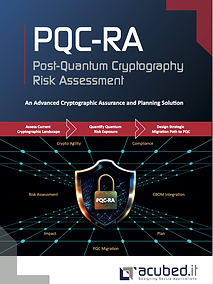Post-Quantum Cryptography Risk Assessment

A Comprehensive Risk Assessment for Post-Quantum Cryptography Readiness
Quantum Vulnerability Diagnosis
This Quantum-Vulnerability Diagnosis step focuses on identifying cryptographic risks in an organisation’s existing infrastructure. It categorises systems based on PQC personas (Urgent, Regular, Cryptography Provider) and assesses vulnerabilities within cryptographic policies, asset management, and quantum risk scoring.
The process includes:
-
Inventory of cryptographic assets used across applications, databases, and networks.
-
Risk assessment based on algorithm strength, key sizes, and expected quantum threats.
-
Mapping dependencies on third-party vendors and identifying policy gaps.
-
Generating a Cryptographic Bill of Materials (CBOM) to streamline cryptographic discovery and risk tracking.
By structuring encryption assets and their risks, organisations can prioritise high-risk systems, estimate migration effort, and prepare compliance strategies aligned with NIST, ISO, and NCSC guidelines.
Are You Ready for Post-Quantum Security?
Most encryption today is vulnerable to quantum threats, and Mosca’s Inequality warns that organisations must migrate before quantum attacks become feasible. Organisations lack visibility into which cryptographic assets need immediate upgrades.
Without a structured approach, businesses risk non-compliance, data breaches, and operational disruptions due to weak cryptographic implementation.
PQC-RA provides a clear roadmap to help organisations identify encryption risks, assess compliance, and transition securely to post-quantum cryptography.
What is PQC-RA?
PQC-RA (Post-Quantum Cryptographic Risk Assessment) is a comprehensive assessment and advisory tool designed to help businesses and government agencies evaluate encryption vulnerabilities in preparation for quantum computing threats.
PQC-RA processes CBOM data to provide actionable security insights. It evaluates encryption methods, assigns Quantum Risk Scores, and helps businesses identify which encryption standards need urgent upgrades.
By analysing cryptographic data, PQC-RA ensures that organisations can make informed decisions about their security posture. It checks compliance against regulations like NIST, ISO, and NCSC UK to verify that encryption methods align with industry standards.
Additionally, PQC-RA generates detailed reports and structured migration plans, guiding businesses through the process of transitioning to quantum-safe cryptographic solutions while minimising operational risks.

PQC Transition: Deprecation Schedule (NIST)
Organisations should begin phasing out these algorithms and transitioning to PQC:

NSCS Timeline

All traditional cryptographic algorithms that lack quantum resistance must be fully replaced with NIST-approved PQC algorithms.
Transition now to cutting-edge solutions such as ML-KEM, ML-DSA and SLH-DSH.
Map your current Cryptographic Landscape

PQC-RA Benefits
Risk-Based Decision Making
Understand which encryption methods need urgent attention
Quantum Risk Score
Assigns risk levels (low to high) based on encryption vulnerability
CBOM Integration
Works with cryptographic inventory tools
Compliance Analysis
Checks encryption standards against NIST, NCSC, ISO, and more
Custom Migration Planning
Helps organisations transition to post-quantum cryptography without disruptions
Seamless Integration
Works alongside existing security frameworks (SIEM, compliance tools)
When do you use PQC-RA?
When visibility into cryptographic assets is lacking: organisations need a clear inventory of encryption methods in use, along with an assessment of vulnerabilities to quantum threats
When planning a structured transition to PQC:
Migrating to quantum-safe encryption can be complex, requiring a risk-based approach to prioritise updates while maintaining security continuity
When compliance with evolving regulations is required: with security mandates from NIST, ISO, and NCSC, businesses must align their cryptographic strategies to meet industry standards
When ensuring long-term data protection: industries handling sensitive information such as financial transactions, healthcare records, and government communications must proactively address quantum risks before encryption weaknesses are exploited

